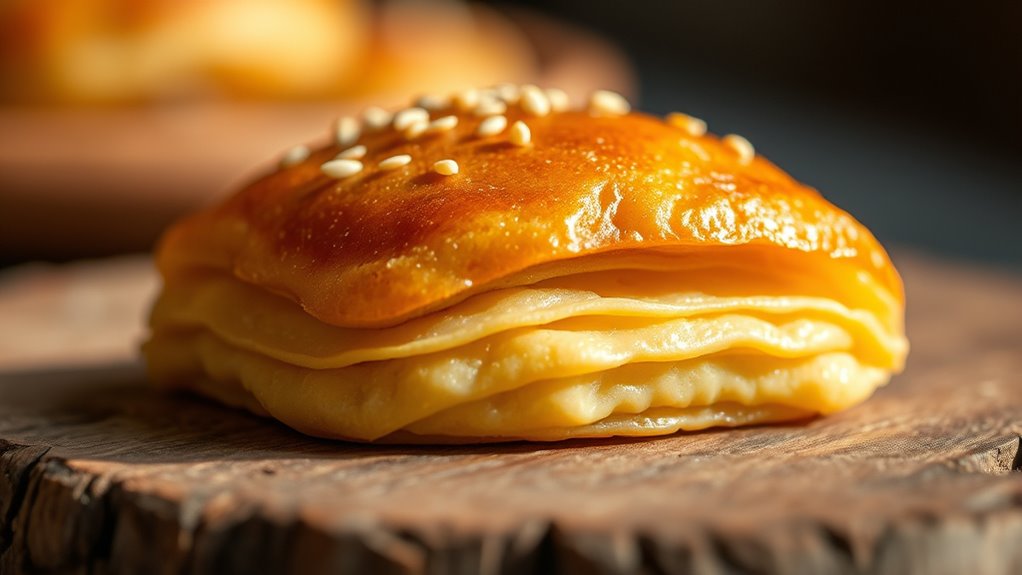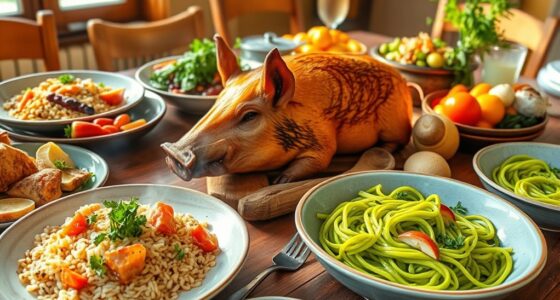Piricchittu is a famous traditional sweet from Ittiri, reflecting the town’s rich cultural and culinary heritage. Made with locally sourced ingredients like wheat flour, lard, and natural flavorings, artisans craft these treats using age-old techniques passed down through generations. Celebrated during festivals and special occasions, Piricchittu symbolizes community pride and regional identity. To experience its authentic flavors fully, discover how local craftsmanship and customs shape this beloved Sardinian pastry.
Key Takeaways
- Piricchittu is a traditional sweet from Ittiri, Sardinia, symbolizing local heritage and craftsmanship.
- Made with wheat flour, olive oil, and natural ingredients, shaped by skilled artisans using age-old techniques.
- It is prominently featured during festivals and celebrations, representing regional pride and cultural identity.
- The sweet’s layered texture and complex flavors reflect centuries-old Sardinian culinary traditions.
- Piricchittu supports local artisans, farmers, and the regional economy through its production and cultural significance.
The Origins of Piricchittu in Ittiri

The origins of Piricchittu in Ittiri are deeply rooted in the region’s rich culinary and artisanal traditions. As you explore Ittiri’s history, you’ll see how this sweet became a local hallmark, closely tied to the craft sector that defines the town’s economy. The recognition of Ittiri as a city in 2000 helped preserve and promote traditional products like Piricchittu, which are part of the broader Logudoro regional heritage. Situated on a high plateau with rugged terrain, Ittiri’s natural resources and agricultural practices influenced the development of local confectionery. The sweet’s prominence reflects the town’s artisanal food culture, showcasing centuries-old craftsmanship that continues to connect the community’s past with its present. The town’s celebration of local crafts and food further emphasizes the importance of traditional sweets like Piricchittu in maintaining Ittiri’s cultural identity. Additionally, the artisan techniques used in making Piricchittu highlight the skill and dedication passed down through generations, reinforcing its status as a treasured regional specialty.
Key Ingredients and Traditional Recipes
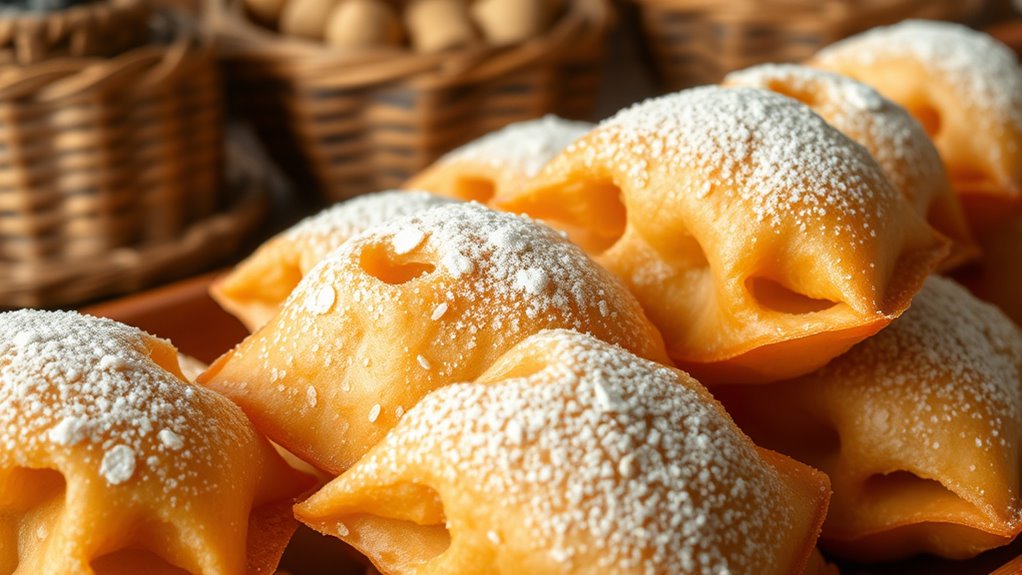
To make Piricchittu in the traditional way, you’ll combine key ingredients like wheat flour, water, and strutto (lard) to form a rich dough. Eggs are added to give structure and a tender texture, while sugar sweetens the mixture and aids in glazing. You’ll also incorporate natural flavorings such as cardamom and cinnamon powders for aroma and taste, with rose water adding a floral fragrance. Nuts are often placed on top for crunch and decoration. Some recipes include sweetened condensed milk for extra creaminess. The dough is mixed thoroughly, shaped, and baked or steamed depending on regional tradition. Additionally, the regional techniques used in preparation influence the final texture and flavor. After cooking, a shiny glaze is applied, and a dusting of spice powders completes the process, resulting in the distinctive, flavorful Piricchittu.
The Craftsmanship Behind Each Sweet

You can see the craftsmanship in every Piricchittu Ittiri sweet through the traditional techniques artisans use with care and precision. Skilled makers follow age-old methods, ensuring each batch reflects their expertise and devotion. Their attention to detail creates a product that’s both authentic and uniquely handcrafted. For instance, the process of kneading the rice flour and carefully frying small dough pieces demonstrates their dedication to achieving the perfect texture and appearance, highlighting the importance of ingredients and preparation techniques in traditional sweet-making. Moreover, the use of traditional tools and methods further emphasizes the artisans’ commitment to preserving cultural heritage.
Traditional Production Techniques
Crafting Piricchittu Ittiri sweets involves a meticulous process that highlights the skill and tradition behind each piece. You start by selecting finely milled wheat flour, often ground with traditional stone mills, to achieve the perfect texture. Local olive oil is preferred for authentic flavor, and natural sweeteners like raw honey or fresh grape must are incorporated. Fresh eggs from free-range chickens add richness and structure, while aromatic spices such as anise seeds enhance the signature taste. During dough preparation, you knead thoroughly to develop elasticity, then let it rest covered for 30 minutes to several hours, maintaining natural moisture. Shaping involves handcrafting or using carved wooden molds, with decorative patterns pressed onto the surface. The sweets are then baked in wood-fired ovens on stone slabs at controlled temperatures, ensuring slow, even cooking. Additionally, some artisans incorporate traditional techniques like using natural fermentation to deepen flavor profiles and preserve authenticity.
Skilled Artisans at Work
Behind each Piricchittu Ittiri sweet, highly skilled artisans meticulously shape and refine every piece, guaranteeing that tradition and craftsmanship shine through in every detail. You witness their expertise in selecting local, high-quality ingredients like fresh almonds and honey, which define the authentic flavor. They master traditional hand-shaping techniques, forming the characteristic small, rounded shape with uniform size for even baking. Precision in baking is vital; artisans control temperature and timing, using sensory cues to avoid over-browning and preserve softness. Quality control is strict—each batch is inspected for consistency, flavor, and appearance. Through apprenticeships and community workshops, they pass down these skills, preserving Ittiri’s sweet-making heritage for generations to come. Somatic therapy techniques are sometimes used to enhance the focus and mindfulness of artisans during their craft, ensuring each step is performed with care and presence.
- Expert ingredient selection guarantees authentic flavor
- Hand-shaping maintains traditional aesthetics
- Strict baking controls preserve texture
- Continuous skill transfer sustains tradition
Cultural Significance and Local Celebrations
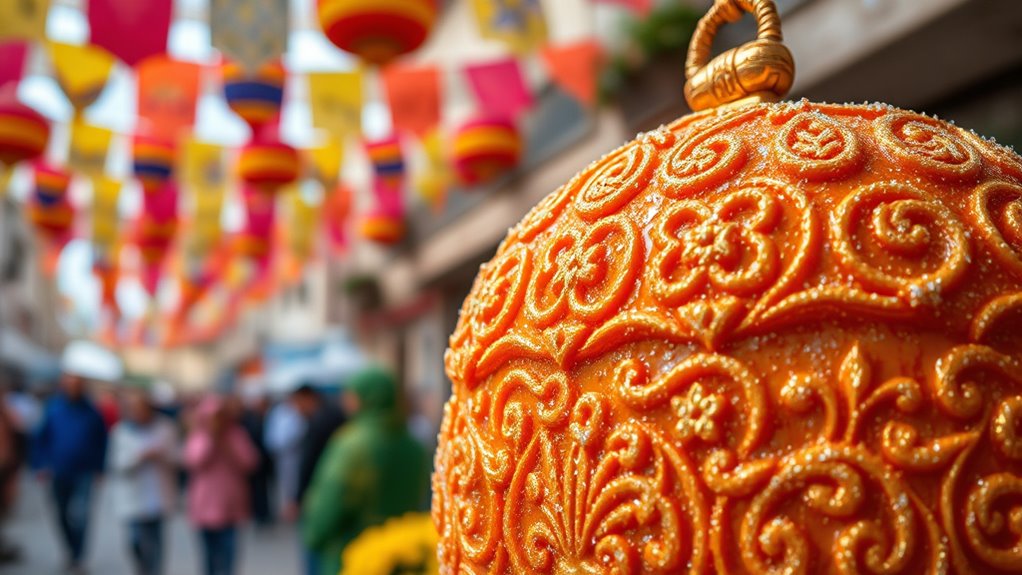
You’ll see how Piricchittu plays a crucial role in Ittiri’s festivals and traditions, symbolizing community pride and shared history. During celebrations, it brings people together and highlights the town’s culinary heritage. This sweet isn’t just a treat; it’s a meaningful part of Ittiri’s cultural identity. As a traditional Sardinian confection, Piricchittu embodies the local craftsmanship and regional flavors that have been passed down through generations. Its vibrant colors and unique textures also reflect the cultural significance of regional sweets in fostering community bonds.
Traditions in Festivals
Piricchittu plays a vital role in festival celebrations, serving as a symbol of Sardinian cultural identity and community unity. During festive times like Christmas and cultural gatherings, it’s shared among families and neighbors, strengthening bonds. You’ll see it prominently displayed in food stalls and markets, highlighting its importance. Its preparation, often passed down through generations, involves community participation, making it a collective ritual. Local ingredients reinforce the connection to regional agriculture, emphasizing authenticity. Sharing Piricchittu during festivals isn’t just about taste; it’s a gesture of hospitality and tradition. It also boosts the local economy by supporting artisans and small producers, while fostering a sense of pride. Overall, it embodies the spirit of community, tradition, and Sardinian heritage during celebrations. Additionally, celebrity lifestyle insights reveal how cultural traditions like Piricchittu can influence regional identity and pride beyond Sardinia.
Symbol of Community Pride
Piricchittu stands as a powerful symbol of Ittiri’s community pride and cultural identity, embodying the town’s artisanal traditions and regional heritage. This sweet reflects the collective craftsmanship and historical agricultural roots of Ittiri, reinforcing local pride. Its production and sharing during festivals and celebrations strengthen community bonds, highlighting a shared cultural heritage. Local artisans and businesses dedicated to Piricchittu sustain the economy while showcasing regional skills. During major events like Christmas, the sweet takes center stage, symbolizing hospitality and unity. Beyond celebrations, Piricchittu acts as a cultural ambassador, representing Ittiri’s rich culinary traditions in broader Sardinian and Italian contexts. Its continued popularity fosters intergenerational knowledge transfer and reinforces the town’s unique identity, making it a true emblem of local pride. Incorporating positive thinking practices can enhance community engagement and foster a more resilient cultural identity, further strengthening the sense of pride associated with Piricchittu community pride.
Historical Culinary Heritage
The rich culinary heritage of Ittiri is deeply rooted in its traditional sweet-making techniques, which have been passed down through generations. Piricchittu reflects this legacy, crafted by artisans using age-old methods that preserve authenticity. Its recipe draws on the agricultural riches of Logudoro, incorporating indigenous Sardinian ingredients that connect the sweet to the land. This craft is a crucial part of Ittiri’s cultural identity and local economy, embodying centuries of tradition. During festivals and celebrations, Piricchittu plays a prominent role, symbolizing community pride and hospitality. The sweet’s presence at these events reinforces intergenerational bonds and cultural memory. Moreover, the preservation of such culinary practices helps sustain traditional crafts, ensuring the continuation of cultural identity for future generations.
The Role of Piricchittu in Sardinian Heritage
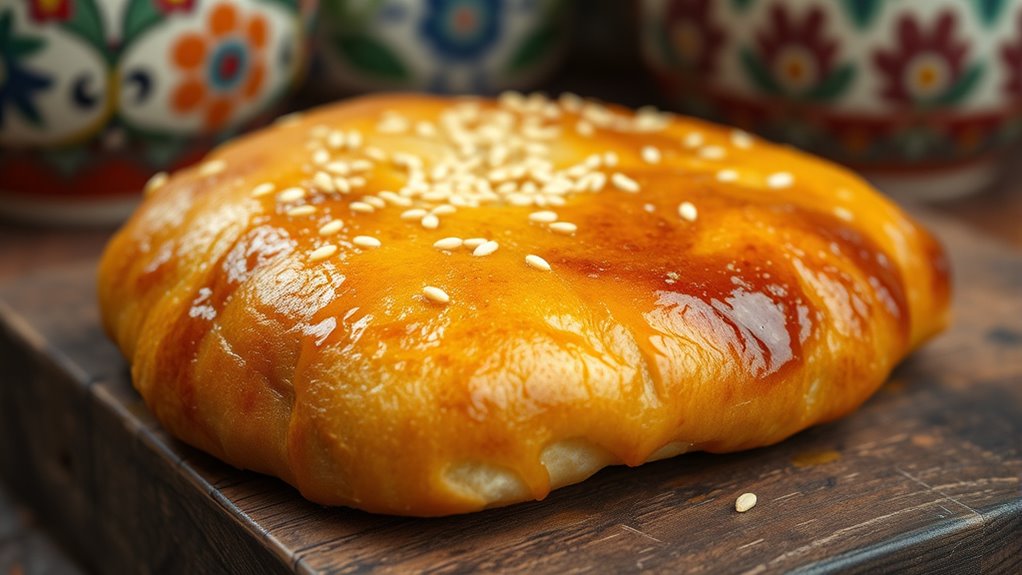
As an essential symbol of Sardinian identity, Piricchittu embodies the island’s rich cultural and culinary traditions. It connects you to centuries-old practices, passed down through generations, and plays a crucial role in local festivals and celebrations. When you enjoy Piricchittu during religious feasts, you experience a tangible link to Sardinia’s deep-rooted religious and cultural heritage. It also serves as a regional marker, highlighting Ittiri’s unique gastronomy and fostering community pride. By supporting local artisans and farmers, Piricchittu sustains the island’s rural economy and preserves native ingredients. It reinforces Sardinia’s identity amid globalization, showcasing its traditional diet and cultural resilience. Additionally, these sweets often incorporate local ingredients like honey and nuts, which have been part of Sardinian culinary heritage since ancient times. Cultural preservation is further strengthened by the continuation of traditional recipes and techniques passed down through generations. In this way, Piricchittu isn’t just a sweet—it’s a living symbol of Sardinian history, community, and regional pride.
Production Methods and Local Artisans
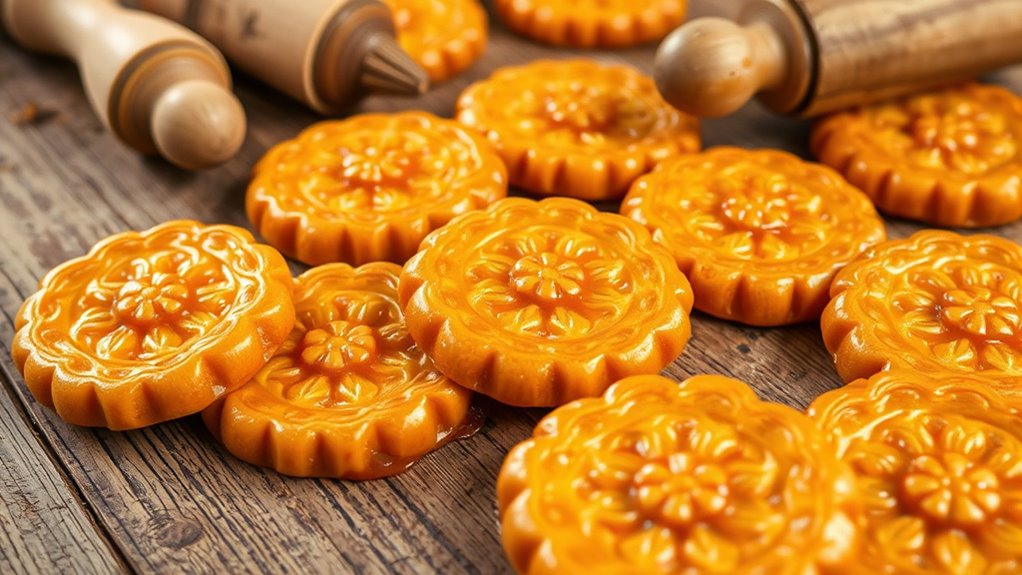
Traditional production methods for Piricchittu rely on skilled local artisans who preserve age-old techniques passed down through generations. You’ll notice that they source ingredients locally, like Sardinian wheat flour and olive oil, which are essential for authentic texture and flavor. Hand-kneading the dough ensures the right consistency and prevents overworking, maintaining the crumbly quality. Artisans also use natural leavening agents and traditional egg preparations to keep the classic taste. Baking in wood-fired ovens adds a distinctive aroma and even cooking. Final shaping and scoring are done manually, preserving traditional patterns unique to Ittiri.
- Emphasis on tactile skills and sensory evaluation over mechanization
- Small-scale, home-based workshops for artisanal quality
- Family-run operations with seasonal peaks during festivals
- Limited automation to maintain product authenticity
Economic Impact on Ittiri and Sardinia
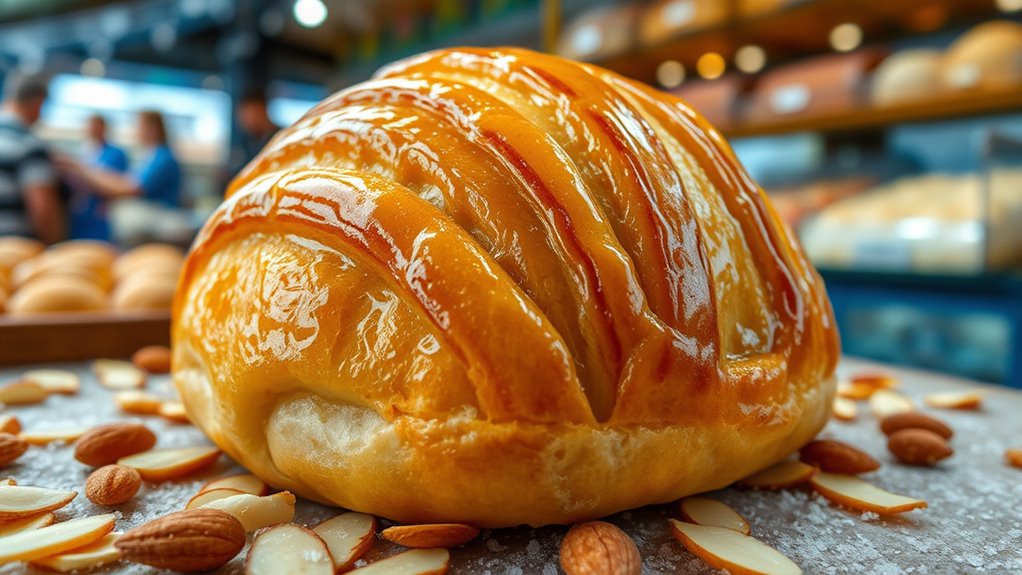
Piricchittu considerably boosts Ittiri’s local economy by supporting small artisanal businesses, sustaining traditional craftsmanship, and attracting tourists. It fuels the livelihoods of local confectioners, farmers, and artisans, creating a vibrant economic cycle. The sweet enhances Sardinia’s regional economy by expanding exports and boosting gastronomy tourism, strengthening cultural identity. Its production sustains skills, generates employment, and encourages entrepreneurship, especially in rural areas. Festivals featuring Piricchittu draw visitors, increasing revenue for hospitality, retail, and transport sectors. Here’s a visual of its economic impact:
| Sector | Contribution | Impact |
|---|---|---|
| Artisanal businesses | Job creation, tradition preservation | Keeps craft skills alive, supports small enterprises |
| Agriculture | Raw materials, ingredients | Boosts local farming, sustains sheep milk production |
| Tourism | Festivals, local markets | Attracts visitors, promotes cultural heritage |
| Export & Markets | International sales, diaspora links | Expands Sardinian influence, diversifies income sources |
Furthermore, the local economy benefits from Piricchittu through increased seasonal demand, which helps stabilize incomes during off-peak periods, encouraging year-round economic activity.
Promoting Piricchittu to the World
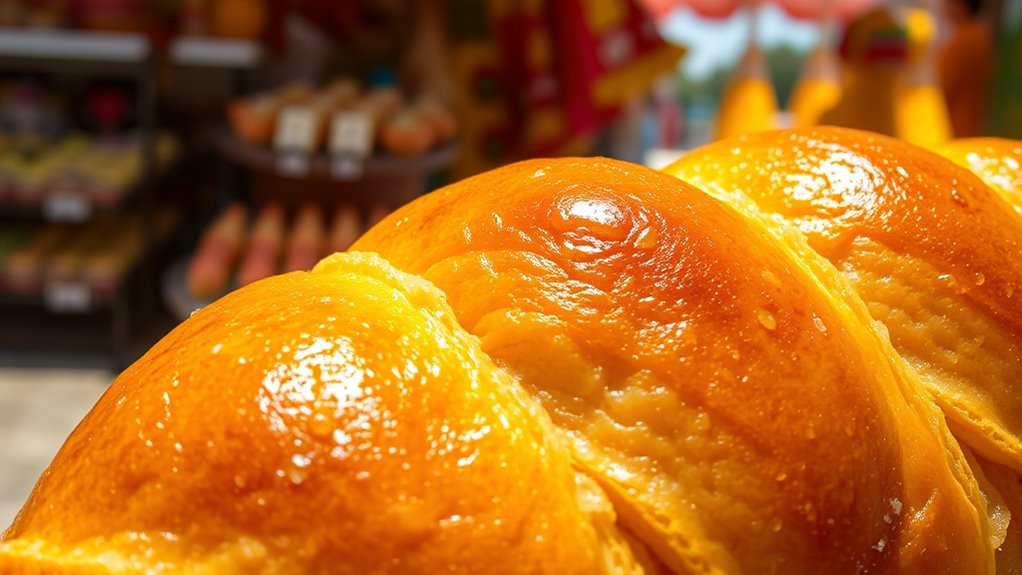
To elevate Piricchittu’s presence on the global stage, it’s essential to harness Sardinia’s rich cultural heritage and craft compelling stories that resonate emotionally with international audiences. You can achieve this through strategic branding and storytelling that highlight the tradition and artisanal craftsmanship behind Piricchittu. Incorporate eye-catching packaging that emphasizes its uniqueness and artisanal nature, appealing to gourmet markets. Collaborate with Sardinian tourism boards to feature Piricchittu at cultural festivals, creating memorable cultural experiences worldwide. Additionally, leverage online platforms and social media campaigns focused on Sardinian gastronomy to reach a broad audience.
- Use storytelling centered on family recipes and local traditions
- Partner with gourmet retailers and international food fairs
- Develop visually appealing, artisanal packaging
- Engage influencers and culinary experts to boost visibility
How to Enjoy and Taste Authentic Piricchittu

For the best experience, serve Piricchittu slightly chilled or at room temperature to enjoy its delicate crunch and layered textures fully. This way, you’ll appreciate the thin, flaky pastry and the subtle sweetness of the filling, which features hints of orange zest and anise seeds. Take your time to savor each bite, noting the aroma of olive oil and mild spices that enhance its flavor. Pair it with a strong Sardinian coffee or a sweet dessert wine like Vermentino to deepen your tasting experience. Traditionally presented on rustic ceramic plates, Piricchittu is perfect as a light snack or dessert. Consume it within a day or two for maximum freshness and crispness. Remember, slow enjoyment highlights its layered textures and complex flavors. Proper storage is essential to maintain its crunchiness and prevent it from becoming soft or soggy over time.
Frequently Asked Questions
How Long Does It Take to Produce Authentic Piricchittu?
You’re wondering how long it takes to produce authentic piricchittu. The process typically spans 2 to 3 hours, starting with ingredient preparation that takes 15 to 30 minutes. You’ll spend 30 to 60 minutes resting and shaping the dough, followed by 15 to 30 minutes baking. Glazing adds another 10 to 20 minutes, with a final 30-minute drying period. Overall, it’s a meticulous process that rewards your effort with delicious results.
Are There Any Variations of Piricchittu Across Sardinian Regions?
Imagine a tapestry woven with regional threads; each Sardinian area adds its unique color. You’ll find variations in Piricchittu, shaped by local ingredients like wild herbs, regional nuts, and honey types, reflecting their landscapes. Preparation methods differ, from artisanal handcrafting to twice-baking. Festivals bring spice and decoration, symbolizing local culture. These differences highlight Sardinia’s rich diversity, making each Piricchittu a delicious emblem of its place and tradition.
Can Piricchittu Be Made Vegan or Gluten-Free?
Yes, you can make this sweet vegan and gluten-free. You’ll need to swap animal fats like lard with vegetable oils and use vegan egg replacers such as flaxseed or chia seeds. For gluten-free options, replace wheat flour with rice or chickpea flour, ensuring proper texture and elasticity. Adjust baking times and techniques accordingly, and consider natural flavorings like cinnamon or rose water to maintain authentic taste.
What Is the History Behind Piricchittu’S Traditional Recipes?
You wonder about the history behind traditional recipes, and it’s like tracing a river back to its source. You’ll find that piricchittu’s recipe reflects Sardinia’s rich cultural tapestry, woven with almonds, sugar, and local ingredients. These recipes symbolize more than flavor—they embody centuries of craftsmanship, community celebrations, and regional pride. As you explore, you connect with generations past, preserving those ancient traditions in every sweet bite.
Where Can Visitors Taste the Best Piricchittu in Ittiri?
If you’re enthusiastic to taste the best Piricchittu in Ittiri, visit local pastry shops near the town center, especially those with top Tripadvisor ratings. These artisanal bakeries often serve freshly made versions, especially during festivals or seasonal events. You can also explore markets for authentic packaged sweets or dine at traditional restaurants and cafés that include Piricchittu in their dessert menus. Festivals are another great opportunity to savor this regional delicacy.
Conclusion
Once you taste Piricchittu, you’ll realize it’s not just a sweet—it’s a legendary taste that captures the soul of Ittiri itself. This tiny treat holds the power to transport you to Sardinia’s heart, making every bite an unforgettable experience. Don’t just take my word for it—dive in and let Piricchittu sweep you off your feet with its irresistible magic. Once you’ve had it, you’ll crave it forever—trust me, it’s that extraordinary.
